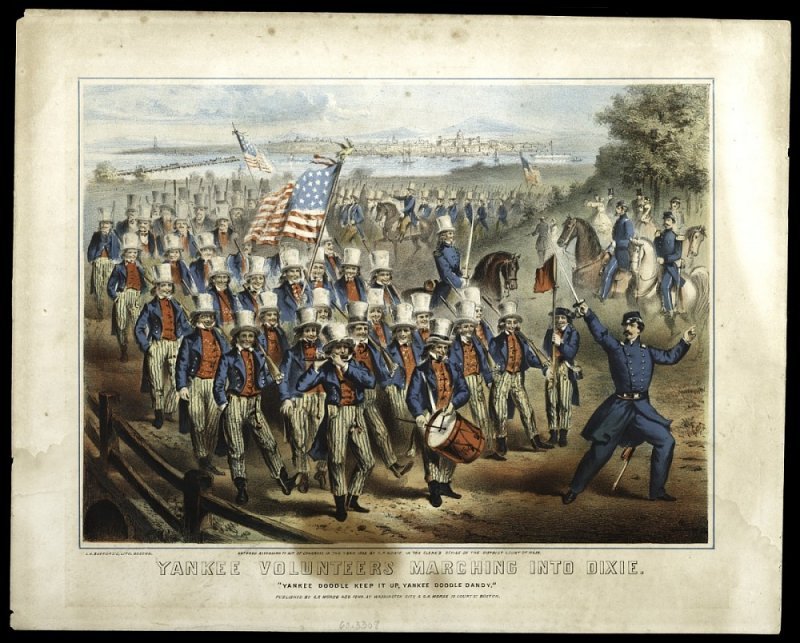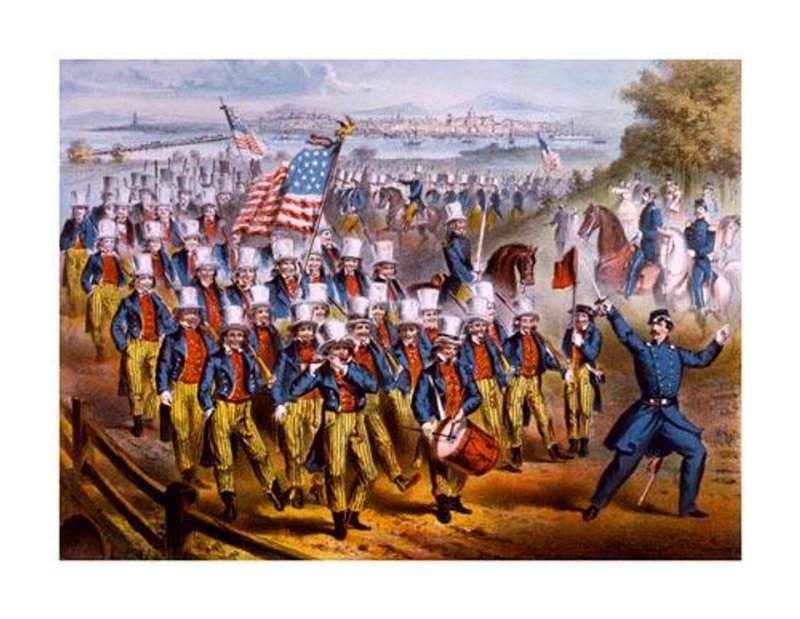
This 1862 chromolithograph of Union soldiers in "Uncle Sam" costumes, parading down a road in formation, led by a uniformed Union officer with a raised sword. The costumes include striped beige pantaloons, blue tailcoats, red vests, white top hats, and jack boots, and each man carries a rifles over his shoulder. A drummer and fife player proceed at the front of the group the men behind them fly several large American flags. This patriotic print portrays the confident and smiling volunteers as righteous heroes, marching for freedom. The unrecognizable topography of the land across the river suggests that this print depicts an imagined view of either Boston, where the lithographer and publisher resided, or Washington, D.C. Visible in the distance is either the domed Massachusetts State House with wings prior to their actual construction or an anticipated vision of the completed U.S. Capitol with dome. Perhaps the indistinct setting was meant to appeal to Union supporters both in New England and nationally. Initially published as a sheet music cover, this colorful print was also used as a recruitment wall print. The image highlights the shift from Brother Jonathan, an early character representing New England and the Northern states, to Uncle Sam, a symbol of the strength of the federal government. By the end of the Civil War, Brother Jonathan had been replaced by this new personification of the American nation.
The lithographer of this print was John Henry Bufford (1829-1870/71). The son of a sign painter and gilder, Bufford trained with Pendleton's Lithography in Boston, 1829-1831. He worked in New York with George Endicott and Nathaniel Currier (1835-1839) before returning to Boston where he developed a reputation for printing and publishing popular prints, commercial work, labels, and trade cards. The company went through several iterations and name changes until about 1865. He became the chief artist for Benjamin Thayer until buying out the firm to found J. H. Bufford & Co. (1844-1851). He continued to work in the lithography and publishing business for the remainder of his life. In 1865, his sons Frank and Henry John became partners in Bufford & Sons or J.H. Bufford’s Sons Litho. Co. After his death they continued the family business as Bufford Brothers and as Bufford Sons Engraving & Lithographing Company until 1911.
The work was copyrighted by Charles Fessenden Morse of Boston. Morse joined the Second Massachusetts Volunteer Infantry in 1861, and was a friend of Robert Gould Shaw, who commanded the 54th Massachusetts Infantry, one of the first all-black regiments formed during the Civil War. Morse fought at Cedar Mountain, Antietam, Chancellorsville, and Gettysburg. After the war, he became influential in Kansas City, Missouri, where he was president of the Kansas City Stockyards.
LOCATION
Currently not on view

